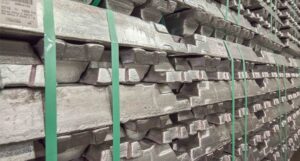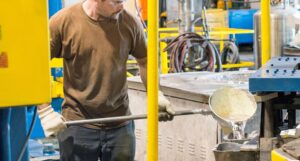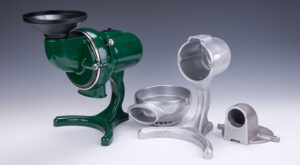We answered the top 25 most frequently asked questions about the permanent mold aluminum casting process.
While the word casting (noun) can be used to describe the finished product, casting (verb) can also be used to the describe the manufacturing method.
Metal casting is the process of pouring molten metal into a custom mold and shaping the metal as it solidifies.
There are three common casting methods: sand casting, die casting, and permanent mold casting. Other casting methods include lost foam casting and investment casting.
Iron, aluminum, bronze, zinc, steel, and copper are common metals used in casting. At Batesville Products, we cast aluminum (A356) and zinc (ZA5 and ZA12).
The aluminum 300 series is common in metal casting. A380 is common in die casting. A356 is common in permanent mold casting and sand casting. This alloy is preferred because of its castability, strength, weight, and corrosion resistance. A356 is also medical-grade and food-safe.

Compared to other metals, cast aluminum is very lightweight. The weight of the casting depends on the size, hollows, and density of the part.
For example, this large casting used on building corners is about twenty pounds.
Cast aluminum is very strong. Since it can withstand weight and stress, it’s often used in construction and industrial machinery.
To further increase strength and remove flexibility properties, aluminum castings can be heat treated. T5 and T6 are common heat treatments.
Rio Tinto, a North American based aluminum producer, uses an advanced hydropower damming system to produce aluminum. Did you know that 40% of the cost of making aluminum is electricity? This hydropower system gives a competitive edge in comparison to coal burning smelters.
However, lots of aluminum in use today is recycled, or secondary. Aluminum is fully recyclable and can be recycled indefinitely without losing quality. Did you know 75% of all aluminum ever produced is still in use today?
There are special air-dry or bake-on primers and paints for aluminum castings.
Powder coating is one of the most common cast aluminum finishes. Know that castings must be prepped, cleaned, and degassed before powder coating for the best results.
Aluminum castings can be anodized or chromated to provide corrosion resistance, oxidation protection, wear resistance, strong insulation, heat transfer properties, and an aesthetic appearance.
You can cast almost anything with aluminum! From frying pans to dental chairs, fan blades to electrical housings. Here are some examples.
Where’s aluminum used? Aluminum is used to make products in hundreds of industries, including…
Unlike iron, aluminum will not rust. To protect against other forms of corrosion, aluminum can be anodized or coated.
Aluminum is known for its high ductility. Unlike other metals, aluminum will bend before it breaks.
Cast aluminum can be welded. It’s possible to cast different aluminum parts and welded them together to assemble your final product.
However, casting your product into 1 piece rather than machining and welding many pieces together saves a lot of time and money. We recommend working with one of our expert engineers to see how you can turn your project into 1 piece.

Permanent mold casting is the gravity-fed process of pouring molten metal into a reusable steel mold.
Both processes use a reusable steel mold to form metal castings. And both processes have a great as-cast surface finishes.
The main difference between die casting and permanent mold casting is the way the metal is fed into the mold. Die castings are quickly pressure injected, while permanent mold castings are gravity-fed by a slow tilt. This slow tilt means less internal porosity that could become an issue during machining.
Die casting tooling is more complex, meaning it can be up to five times more expensive than permanent mold tooling. Therefore, die casting process is ideal for high volume production runs (example: 50,000 pieces per year). It’s commonly used in the automotive industry. Permanent mold is ideal for moderate volume production runs (example: 5,000 pieces per year).
Permanent mold is known for high-quality surface finish, low-porosity, high precision, repeatability, and easy secondary machining.
Permanent mold castings are denser than die or sand castings. Permanent mold is ideal for moderate volume production (500-20,000 pieces per year).
9 factors impact the cost of a casting.
The primary cost driver is mold tooling. Permanent mold casting is less expensive than die casting, but more expensive than sand casting.
Sand molds are one-time use, while permanent molds are reusable steel tools. Sand casting’s low-cost tooling and high piece price makes it ideal for low-volume production. However, you will often see a return on investment on permanent mold tooling if you are producing over 1,000 parts per year.
Die casting molds are complex steel molds that take longer to produce and can be up to five times more expensive than permanent mold. Therefore, you see best ROI on high volume production in die casting, and moderate volume production in permanent mold.
Keep in mind, all parts are custom. For a better cost estimate, please request a quote.
Permanent mold castings generally have a surface finish of RMS 200-420. This is smoother than sand casting (typically 300 to 560 RMS), but rougher than die casting (typically 20 to 120 RMS).

Draft is also known as taper. It is necessary in casting because it helps parts easily eject from the mold.
For permanent mold casting, walls should not be thinner than 0.180 inches.
Avoid isolated thin or thick sections. These can negatively impact flow and solidification, and cause shrinkage.
Permanent mold casting his high-precision, holding tight as-cast tolerances (some twice as tight as sand casting!). For even tighter tolerances, consider adding a quick secondary machining operation.
Read our 2024 Casting Design Guide for all tolerances and design specs.

Castings are near-net shape of the final product. Sometimes, a secondary CNC machining operation is required to achieve tighter tolerances than permanent mold is capable of.
CNC machining also completes drilling, tapping, threading, or milling.
Casting then secondary machining is a great way to create a complex part. By first casting your project, you have a great starting point. Machining a near-net shape instead of a block of billet speeds up the CNC machining process. You can produce a complex part more efficiently.
Not sure if your casting needs CNC machining? Take this quiz.
Permanent mold has a great as-cast surface finish. Aluminum casting finishing options are:
Zinc castings are preferred for mirror buffing or plating.
Not sure which finish to use? Use this flowchart to find your ideal finish.
If you do not include a machine stock allowance in your design, the final part may be out of spec. Account for extra material if CNC machining your casting.
For permanent mold castings with dimensions 0 to 6 inches, add a machine stock allowance of 0.045 inches. For dimensions 6 to 12 inches, add 0.060 machine stock allowance. See the chart for more.

We’re ready to answer them. Contact our team today.